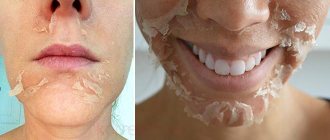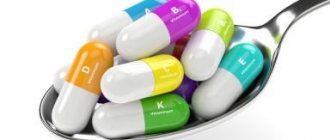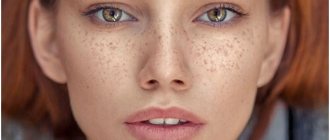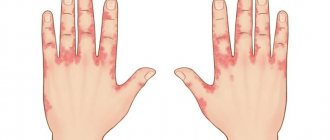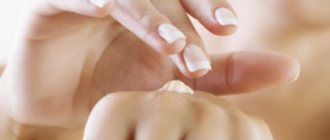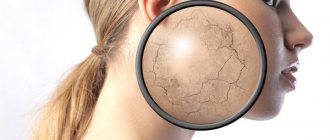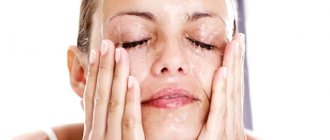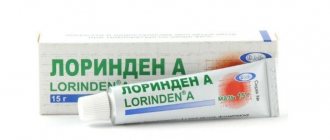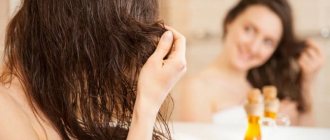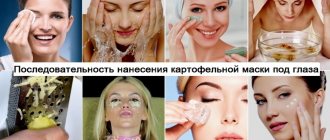Almost every person at some time suffers from inflamed rashes on the face, and also tries to get rid of them as quickly as possible. Usually, this is perceived as a cosmetic defect and few people think that the cause of such skin rashes can be various disorders in the functioning of internal organs and the body as a whole.
Concept, types of acne
An inflamed pimple (papule, pustule, nodule, cyst) is a reddish bump on the skin, which is accompanied by swelling of the adjacent tissues or suppuration. Their occurrence is provoked by pathogenic bacteria that feed on sebum.
Papules
They are small, painless red nodules that protrude slightly above the skin. The papules are hard to the touch, and also lose a little color when pressed, and after disappearing they do not leave any traces, except for small changes in pigmentation in the affected area. When several papules merge, a large painful spot (plaque) appears.
Pustules
Rashes in the form of small painful blisters with white, yellow or yellowish-greenish contents. The cause of their occurrence is a purulent process in the epidermis or dermis. Based on localization, there are epidermal (not deep, passing without a trace) or dermal (deep, leaving scars) pustules.
Nodes
Their main difference from papules and pustules is their large size. The contents in the affected area consist of pus and sebum. Most often, such nodes are accompanied by pain. Due to inflammation of the deep layers of the skin, scars may remain after treatment of the nodes.
Cysts
Accompanied by pain, acquiring a reddish or bluish tint. The cause of their occurrence is purulent decay of the nodes. When palpating the cysts, their hardness and density are noted. If not treated in a timely manner, the cysts connect through the subcutaneous passages, resulting in corresponding scars and scars on the skin.
Causes of acne
The appearance of any kind of rash on the face should prompt not only the idea of how to quickly remove the inflamed area, but also to find out the cause of its occurrence. After all, the culprits for this can be a variety of factors, ranging from harmless to quite serious and dangerous to health and life. Such reasons are conditionally divided into several groups and require more detailed consideration.
Hormonal causes: acne
The appearance of inflamed rashes on the face is the first sign of approaching puberty. This is explained by the activation of steroid hormones and androgens, which provoke increased production and accumulation of excessive amounts of fat in the pores, which is an excellent breeding ground for harmful bacteria. For the same reason, representatives of the fair sex often suffer from inflamed formations on the skin of the face during menstrual bleeding. Sexual dysfunction and excess male hormones in the female body, menopause, pathologies of the pituitary gland or adrenal glands can also make themselves felt by skin rashes. Pregnant women are at risk due to constant surges in the hormone progesterone.
Diseases of internal organs
Based on the nature and location of the rash, an experienced doctor can draw up a clinical picture of the disease in the body.
So:
- rashes on the forehead may indicate illness of the stomach, gallbladder, and pancreas;
- tubercles in the eyebrow area are often caused by intestinal disease;
- the appearance of inflamed pimples on the cheekbones may be a consequence of kidney problems;
- rashes near the lips indicate improper functioning of the digestive system, which is accompanied by colic, constipation, and indigestion;
- Various dysfunctions of the cardiovascular system, as well as the liver, can cause a rash on the nose.
Inflamed acne on the face can be the first alarm bell for thyroid dysfunction.
Poor nutrition and lifestyle
Sweet, salty, spicy, and fatty foods increase oil production and, as a result, expose the skin to rashes. The reason for the appearance of acne on the face often lies in excessive consumption of coffee, especially on an empty stomach, as well as the constant presence of nuts in the diet. Excessive consumption of alcoholic beverages and smoking will negatively affect the skin, as they contain toxins that contribute to the development of skin rashes.
External stimuli
These include touching your face with dirty hands, as a result of which bacteria penetrate deep into the skin, thereby causing the formation of acne. There is no need to overdo it with washing, which helps to get rid of both harmful bacteria and good ones, which leads to dry and irritated skin. Poor quality cosmetics or improper use of them leads to clogged pores. Excessive exposure to the sun, as well as in hot rooms, predisposes to the development of inflamed bumps on the skin, since the secreted sweat mixes with oil in the pores, creating a favorable environment for harmful bacteria.
Preventing acne
The best treatment is prevention. Performing the following steps will answer the question of how to get rid of and protect yourself from the attack of inflamed acne:
- regularly visit a cosmetologist for professional facial cleansing;
- consume sweets in moderation, as well as fried, spicy and salty foods;
- annually undergo a preventive examination by a doctor in order to diagnose diseases of internal organs;
- carry out timely treatment of concomitant diseases;
- choose the right cosmetics and do not overdo it with foundation and other products that lead to clogging of pores;
- do not abuse alcoholic beverages, and also avoid smoking;
Under no circumstances should you squeeze out a pimple on your face yourself, as this leads to the formation of new rashes and can provoke an infection, after which it will be much more difficult to remove the inflamed areas and will lead to protracted treatment.
The best masks for inflammation on the face at home: reviews and useful tips
As mentioned above, no one is immune from such cosmetic problems, so do not neglect useful remedies for their treatment and prevention, because the results of using masks against inflammation of the facial skin at home have the most beneficial effect on its condition:
- Redness disappears, pores and clogged sebaceous channels are cleaned;
- Relapse of the disease is prevented;
- Scars become lighter, and pimples and rashes disappear completely.
Treatment
There is no single answer to the question of how to treat acne on the face; it all depends on their nature, cause and type. Combining cosmetic, medicinal and folk methods allows you to both cure the rash itself and its consequences.
Treatment with cosmetics
It is recommended to treat inflamed areas with the help of cosmetics that contain the following components:
- salicylic acid, which has an antibacterial, as well as anti-inflammatory and whitening effect;
- zinc oxide, which affects the production of oil by the sebaceous glands;
- hemmamelis extract, which has wound healing properties;
- chamomile extract as the best drying agent;
- triclosan, which has the property of preventing bacterial contamination;
- alpha hydroxyl acids that help eliminate dead skin cells and collagen synthesis.
Cosmetologists also recommend giving preference to products based on green tea extract, which can soothe and tone irritated skin.
Drug treatments
Medications for the treatment of rashes on the face can tell you how to remove skin rashes. Their action is aimed at suppressing the work of the sebaceous glands, eliminating the inflammatory process, and suppressing the infection that causes acne. Differin cream, Benzoyl peroxide gel, Tretitonin, Azelaic acid, Chlorhexidine, Ichthyol ointment, Salicylic acid, Skinorin, Curiosin, Bazeron, Zinerit, Salicylic-zinc paste and others have proven themselves well. The course of treatment consists of applying medications to the affected area and lasts from a month to three. The remedy for the disease, dosage, and treatment regimen should be prescribed exclusively by a dermatologist.
Traditional methods of treatment
Alternative medicine methods play a large role in the treatment of inflamed acne. They are especially popular among expectant mothers, for whom most medications are contraindicated and treatment of rashes comes down to so-called grandmother’s recipes.
The following recommendations will tell you how to remove bumps from your face:
- rubbing the affected areas with aloe and plantain juice, as well as pumpkin;
- compresses from an infusion of two tablespoons of bitter wormwood and a glass of boiling water;
- applying lotions from a teaspoon of tincture of calendula and honey diluted in a glass of water to problem areas;
- washing with a decoction of sage and chamomile;
- a mask of grated raw potatoes and egg whites, which must be applied for 15-20 minutes;
- a mask based on honey and lemon, applied to the affected area for 10 minutes.
There are many similar recipes, among which everyone can choose to their liking. Before using traditional methods of combating skin inflammation, it is still necessary to consult a doctor in order to establish the root cause of their occurrence.
Folk remedies for inflamed skin
This mask is one of the most effective and fastest-acting, but its main component, tea tree essential oil, has a not very pleasant smell and creates a slight burning sensation, so this recipe is not suitable for allergy sufferers and people with hypersensitive skin.
To prepare the mask, you need to take tea tree essential oil, dry green, black or blue clay and a little boiling water. First you need to dissolve a teaspoon of clay in boiling water, while the mixture should remain quite thick, like sour cream. After this, you need to add 1-2 drops of oil (over time, when the skin gets used to the burning, you can add 3-4).
DETAILS: Description and application of Wartner Nailexpert against fungus
The mask should be applied to damp skin in a thick layer, without affecting the thin skin around the eyes. You need to keep the composition for 10-15 minutes, and it should not dry out; for this you can regularly spray your face with boiled water. It is better to wash off the mask with cold water - this will reduce the burning sensation, and after that you need to apply a moisturizer to avoid dryness.
The second recipe is suitable for those who have flaking and a feeling of skin tightness at the sites of inflammation. To prepare this mask, you need to take a teaspoon of heated honey, a pinch of soda, half a teaspoon of lemon juice and full-fat cottage cheese. All ingredients must be mixed well and applied all over the face, leave for 15 minutes.
Lemon juice and cottage cheese in the mask will whiten redness, baking soda will exfoliate the skin, and honey will moisturize and soften it. It is better to wash off the mask with a decoction of chamomile or celandine. After this, if desired, you can apply cream, but this is not necessary, since cottage cheese and honey take good care of the face.
This mask is suitable for those with problematic skin that often suffers from acne and inflammation. This may be due to excess fat content, pathogenic bacteria in the skin flora and other factors. The components of the product reduce the production of sebum, reduce the number of harmful microorganisms, and also lighten inflammation.
To prepare, you need to take 2 tablets of activated carbon, 1 tablet of chloramphenicol, 2 tablets of salicylic acid and calendula tincture (can be replaced with water if desired). All solid components must be crushed into crumbs and poured with liquid, bringing to the state of thick sour cream. After this, apply the mixture to damp skin, leave for 15 minutes and rinse with cool water, after half an hour you can apply the cream.
It is recommended to use this mask no more than once a week, since it contains a surface antibiotic; its abuse can disrupt the composition of the normal microflora of the skin.
Chamomile mask for oily skin: 1 tbsp. chamomile, pour 200 ml of boiling water and leave for 15 minutes.
Soak gauze in the infusion and evenly apply chamomile on it.
If your skin is dry, apply moisturizer after the mask. Chamomile effectively relieves inflammation, but dries out the skin.
Vegetable mask for irritations: finely grate a small cucumber. Add 1 tbsp to the pulp. lemon juice.
You can also apply thin slices of cucumber to your face; they also cope well with irritations.
Protein mask for teenage acne: beat fresh egg white. Apply a thin layer on the face. When this layer dries a little, apply the next one, and so on several times.
Nettle mask for acne: grind 2 tbsp. nettle leaves. Pour 200 ml of boiling water and leave for 1 hour. Drain the water, distribute the nettle evenly over gauze and apply to the face. Wash with cooled nettle infusion, and after a few minutes with plain clean water.
Bread mask for oily skin: 2 tbsp. Mix black bread crumbs with 1 tsp. liquid honey. Knead the “dough” and form it into a flat cake. Apply it to the inflamed area of the face. Wash off after 10 minutes. For severe inflammation, it is recommended to use such cakes daily for two weeks.
Oatmeal mask: stir 3 tsp. oatmeal and milk. Leave to swell for 10-15 minutes. Apply evenly to face.
Sour cream mask: crumble 10 g of fresh yeast.
Add 1 tbsp. sour cream and 1 tsp. plantain juice, stir.
The mask helps relieve inflammation and prevent acne.
Strawberry mask for normal skin with acne: mash 3 tbsp. strawberries
Add 2 tsp. grapefruit juice. Beat 1 fresh egg and add a teaspoon of egg to the rest of the ingredients.
Quince mask for acne: rub 1 quince fruit to make a puree with juice. Apply for 15 minutes. Mix 1 tbsp in a liter of water. lemon juice. Wash your face with this acidified water after the mask. Wait another 5-10 minutes and wash with warm water.
